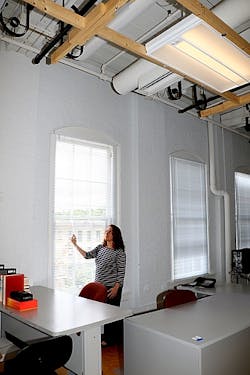In a large open office on the fourth floor of the Lighting Research Center (LRC) at Rensselaer Polytechnic Institute, lighting scientist Leora Radetsky lifts the blinds and lets in the sunlight. The overhead LED luminaires dim in response, fluidly, maintaining consistent light levels on the desk spaces. She lowers the blinds and the luminaires instantaneously increase light levels in response.
Interested in more articles & announcements on smart lighting?
“These intelligent luminaires with integrated sensors and controls promise ideal light levels on the workplane with significant energy savings,” said Radetsky, who is leading a team of researchers to evaluate this emerging technology, in a study funded by the Bonneville Power Administration (BPA) and Washington State University.
Since each luminaire has a built-in occupancy sensor, ideally, the system can more accurately determine when a person is in the room, compared with motion sensors of the past decade. After a specified vacancy period, the luminaires fade from a task level to a background level or switch off. The integrated photosensors, with automatic dimming daylight harvesting, also promise to maintain consistent light levels in response to fluctuations in available daylight.
Radetsky and her team are evaluating commercially-available intelligent LED luminaires with integrated sensors and controls to examine system operational characteristics, commissioning, and energy savings under field conditions, and conducting human factors experiments to study installation and usability. The systems are being evaluated in a daylighted office space and a conference room at the LRC.
The research team has published their initial findings, and the report is available at the BPA website. The LRC’s Lighting Energy Alliance (LEA) partnered with BPA on this phase of the project to expand the number of products evaluated. Current LEA members are Efficiency Vermont, Energize Connecticut, and National Grid.
Key findings from the report include the fact that the systems have the potential for significant energy savings compared to time clock control or power density requirements, although energy usage depends on the system configuration. Manual-on controls appear to save more energy than automatic-on controls. One system provided access via USB to instantaneous power readings. Beyond that, none of the systems logged or reported energy usage.
Regarding installation and usability, the LRC found that all of the products tested were easy to install, but challenging to commission. Initialization of some of the wireless dimming wall switches was complicated, and the systems appeared to lack any mechanism to adjust the default sensor-to-task light ratio. In some cases, this produced low light levels and occupant dissatisfaction. When the ambient light levels were dim, occupants were satisfied with products that provided manual override capability, and products without this capability were less satisfying. Additional findings are available in the full report.
Radetsky is currently evaluating three additional systems with integrated sensors and controls, and expects to have a report published by the end of the year.
About the LRC
The Lighting Research Center (LRC) at Rensselaer Polytechnic Institute is the world's leading center for lighting research and education. Established in 1988 by the New York State Energy Research and Development Authority (NYSERDA), the LRC has been pioneering research in solid-state lighting, light and health, transportation lighting and safety, and energy efficiency for nearly 30 years. LRC lighting scientists with multidisciplinary expertise in research, technology, design, and human factors, collaborate with a global network of leading manufacturers and government agencies, developing innovative lighting solutions for projects that range from the Boeing 787 Dreamliner to U.S. Navy submarines to hospital neonatal intensive-care units. LRC researchers conduct independent, third-party testing of lighting products in the LRC's state of the art photometric laboratories, the only university lighting laboratories accredited by the National Voluntary Laboratory Accreditation Program (NVLAP Lab Code: 200480-0). In 1990, the LRC became the first university research center to offer graduate degrees in lighting and today, offers a M.S. in lighting and a Ph.D. to educate future leaders in lighting. With 35 full-time faculty and staff, 15 graduate students, and a 30,000 sq. ft. laboratory space, the LRC is the largest university-based lighting research and education organization in the world.
Contact:
Rebekah Mullaney - Lighting Research Center, Rensselaer Polytechnic InstituteE-mail:
[email protected]Web site:
Locate more smart lighting vendors in the LEDs Magazine Suppliers Directory
Submit new products, case studies/projects, and other press releases at http://www.ledsmagazine.com/content/leds/en/addcontent.html.
More from LRC:
Lighting Research Center issues response to AMA report on LED lighting
Lighting Research Center will establish OLED lighting program to assist manufacturers and OLED industry





